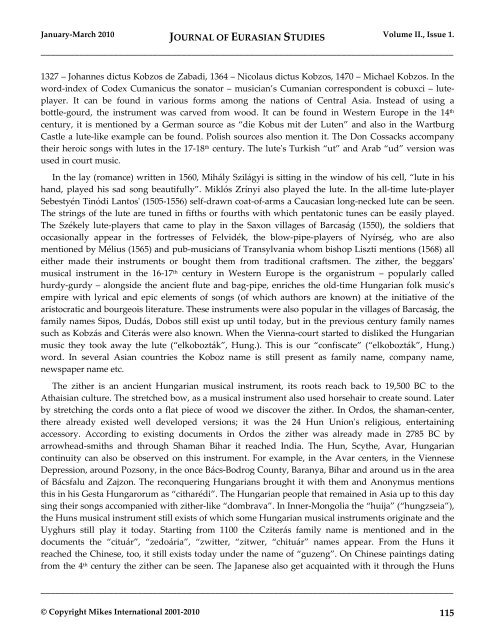EurasianStudies_0110..
EurasianStudies_0110..
EurasianStudies_0110..
You also want an ePaper? Increase the reach of your titles
YUMPU automatically turns print PDFs into web optimized ePapers that Google loves.
January-March 2010 JOURNAL OF EURASIAN STUDIES Volume II., Issue 1.<br />
_____________________________________________________________________________________<br />
1327 – Johannes dictus Kobzos de Zabadi, 1364 – Nicolaus dictus Kobzos, 1470 – Michael Kobzos. In the<br />
word-index of Codex Cumanicus the sonator – musician’s Cumanian correspondent is cobuxci – luteplayer.<br />
It can be found in various forms among the nations of Central Asia. Instead of using a<br />
bottle-gourd, the instrument was carved from wood. It can be found in Western Europe in the 14 th<br />
century, it is mentioned by a German source as “die Kobus mit der Luten” and also in the Wartburg<br />
Castle a lute-like example can be found. Polish sources also mention it. The Don Cossacks accompany<br />
their heroic songs with lutes in the 17-18 th century. The lute's Turkish “ut” and Arab “ud” version was<br />
used in court music.<br />
In the lay (romance) written in 1560, Mihály Szilágyi is sitting in the window of his cell, “lute in his<br />
hand, played his sad song beautifully”. Miklós Zrínyi also played the lute. In the all-time lute-player<br />
Sebestyén Tinódi Lantos' (1505-1556) self-drawn coat-of-arms a Caucasian long-necked lute can be seen.<br />
The strings of the lute are tuned in fifths or fourths with which pentatonic tunes can be easily played.<br />
The Székely lute-players that came to play in the Saxon villages of Barcaság (1550), the soldiers that<br />
occasionally appear in the fortresses of Felvidék, the blow-pipe-players of Nyírség, who are also<br />
mentioned by Mélius (1565) and pub-musicians of Transylvania whom bishop Liszti mentions (1568) all<br />
either made their instruments or bought them from traditional craftsmen. The zither, the beggars'<br />
musical instrument in the 16-17 th century in Western Europe is the organistrum – popularly called<br />
hurdy-gurdy – alongside the ancient flute and bag-pipe, enriches the old-time Hungarian folk music's<br />
empire with lyrical and epic elements of songs (of which authors are known) at the initiative of the<br />
aristocratic and bourgeois literature. These instruments were also popular in the villages of Barcaság, the<br />
family names Sipos, Dudás, Dobos still exist up until today, but in the previous century family names<br />
such as Kobzás and Citerás were also known. When the Vienna-court started to disliked the Hungarian<br />
music they took away the lute (“elkobozták”, Hung.). This is our “confiscate” (“elkobozták”, Hung.)<br />
word. In several Asian countries the Koboz name is still present as family name, company name,<br />
newspaper name etc.<br />
The zither is an ancient Hungarian musical instrument, its roots reach back to 19,500 BC to the<br />
Athaisian culture. The stretched bow, as a musical instrument also used horsehair to create sound. Later<br />
by stretching the cords onto a flat piece of wood we discover the zither. In Ordos, the shaman-center,<br />
there already existed well developed versions; it was the 24 Hun Union's religious, entertaining<br />
accessory. According to existing documents in Ordos the zither was already made in 2785 BC by<br />
arrowhead-smiths and through Shaman Bihar it reached India. The Hun, Scythe, Avar, Hungarian<br />
continuity can also be observed on this instrument. For example, in the Avar centers, in the Viennese<br />
Depression, around Pozsony, in the once Bács-Bodrog County, Baranya, Bihar and around us in the area<br />
of Bácsfalu and Zajzon. The reconquering Hungarians brought it with them and Anonymus mentions<br />
this in his Gesta Hungarorum as “citharédi”. The Hungarian people that remained in Asia up to this day<br />
sing their songs accompanied with zither-like “dombrava”. In Inner-Mongolia the “huija” (“hungzseia”),<br />
the Huns musical instrument still exists of which some Hungarian musical instruments originate and the<br />
Uyghurs still play it today. Starting from 1100 the Cziterás family name is mentioned and in the<br />
documents the “cituár”, “zedoária”, “zwitter, “zitwer, “chituár” names appear. From the Huns it<br />
reached the Chinese, too, it still exists today under the name of “guzeng”. On Chinese paintings dating<br />
from the 4 th century the zither can be seen. The Japanese also get acquainted with it through the Huns<br />
_____________________________________________________________________________________<br />
© Copyright Mikes International 2001-2010 115

















